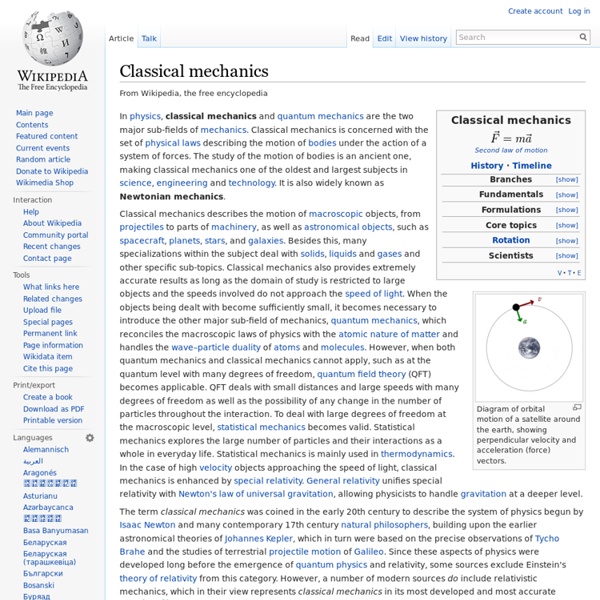Classical mechanics

Theory of relativity
The theory of relativity, or simply relativity in physics, usually encompasses two theories by Albert Einstein: special relativity and general relativity.[1] Concepts introduced by the theories of relativity include: Measurements of various quantities are relative to the velocities of observers. In particular, space contracts and time dilates.Spacetime: space and time should be considered together and in relation to each other.The speed of light is nonetheless invariant, the same for all observers. The term "theory of relativity" was based on the expression "relative theory" (German: Relativtheorie) used in 1906 by Max Planck, who emphasized how the theory uses the principle of relativity. Scope[edit] The theory of relativity transformed theoretical physics and astronomy during the 20th century. In the field of physics, relativity improved the science of elementary particles and their fundamental interactions, along with ushering in the nuclear age. Two-theory view[edit] History[edit]
Thermodynamics
Annotated color version of the original 1824 Carnot heat engine showing the hot body (boiler), working body (system, steam), and cold body (water), the letters labeled according to the stopping points in Carnot cycle Thermodynamics applies to a wide variety of topics in science and engineering. Historically, thermodynamics developed out of a desire to increase the efficiency and power output of early steam engines, particularly through the work of French physicist Nicolas Léonard Sadi Carnot (1824) who believed that the efficiency of heat engines was the key that could help France win the Napoleonic Wars.[1] Irish-born British physicist Lord Kelvin was the first to formulate a concise definition of thermodynamics in 1854:[2] "Thermo-dynamics is the subject of the relation of heat to forces acting between contiguous parts of bodies, and the relation of heat to electrical agency." Introduction[edit] A thermodynamic system can be defined in terms of its states. History[edit] Etymology[edit]
Statistical mechanics
Statistical mechanics is a branch of mathematical physics that studies, using probability theory, the average behaviour of a mechanical system where the state of the system is uncertain.[1][2][3][note 1] The present understanding of the universe indicates that its fundamental laws are mechanical in nature, and that all physical systems are therefore governed by mechanical laws at a microscopic level. These laws are precise equations of motion that map any given initial state to a corresponding future state at a later time. A common use of statistical mechanics is in explaining the thermodynamic behaviour of large systems. Statistical mechanics also finds use outside equilibrium. Principles: mechanics and ensembles[edit] In physics there are two types of mechanics usually examined: classical mechanics and quantum mechanics. Using these two ingredients, the state at any other time, past or future, can in principle be calculated. Statistical thermodynamics[edit] Fundamental postulate[edit]
Quantum mechanics
Description of physical properties at the atomic and subatomic scale Quantum mechanics is a fundamental theory in physics that describes the behavior of nature at and below the scale of atoms.[2]: 1.1 It is the foundation of all quantum physics including quantum chemistry, quantum field theory, quantum technology, and quantum information science. Classical physics, the collection of theories that existed before the advent of quantum mechanics, describes many aspects of nature at an ordinary (macroscopic) scale, but is not sufficient for describing them at small (atomic and subatomic) scales. Most theories in classical physics can be derived from quantum mechanics as an approximation valid at large (macroscopic) scale.[3] Overview and fundamental concepts Quantum mechanics allows the calculation of properties and behaviour of physical systems. A fundamental feature of the theory is that it usually cannot predict with certainty what will happen, but only give probabilities. . and , where Here
Related:
Related:



